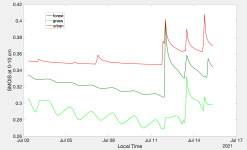Yichen Yang
New member
Hi all,
I need some help to understand what I'm seeing in my modeling results. I'm running a 2-way nested case with double-domain in Guangzhou, China, a city with humid summer. I use WRF and WPS 3.9, MODIS 21-category land use data, and BNU global soil type data, all can be accessed from the wrf user web. (https://www2.mmm.ucar.edu/wrf/users/download/get_sources_wps_geog.html). I used unified Noah LSM, with no mosaic approach used, and no UCM coupled.
I'm observing:
(1) The latent heat flux (LH) for urban grids is consistently zero.
(2) The soil moisture, no matter for what layer (0-10/10-40/40-100/100-200cm), is higher for urban grids than for vegetated grids.
For the zero latent heat flux, I guess the reason is that the urban land is free of vegetation as the dominant approach is used. UCM assumes that urban grids have vegetations but it's not coupled in my case. So this is expected or not too surprising. But am I right?
However, the higher soil moisture for urban grids than for vegetated grids is counterintuitive to me. My results are showing that soil moisture for both type of grids changes with time, but urban soil moisture is consistently higher than vegetation soil moisture by ~0.07. I wonder why that happened. My understanding is that urban grids, at least in the dominant approach, are pure urban, so they are impervious. So what does the 'soil layer' actually mean for such man-made material which cannot hold water? Does it physically make sense?
Thank you very much
I need some help to understand what I'm seeing in my modeling results. I'm running a 2-way nested case with double-domain in Guangzhou, China, a city with humid summer. I use WRF and WPS 3.9, MODIS 21-category land use data, and BNU global soil type data, all can be accessed from the wrf user web. (https://www2.mmm.ucar.edu/wrf/users/download/get_sources_wps_geog.html). I used unified Noah LSM, with no mosaic approach used, and no UCM coupled.
I'm observing:
(1) The latent heat flux (LH) for urban grids is consistently zero.
(2) The soil moisture, no matter for what layer (0-10/10-40/40-100/100-200cm), is higher for urban grids than for vegetated grids.
For the zero latent heat flux, I guess the reason is that the urban land is free of vegetation as the dominant approach is used. UCM assumes that urban grids have vegetations but it's not coupled in my case. So this is expected or not too surprising. But am I right?
However, the higher soil moisture for urban grids than for vegetated grids is counterintuitive to me. My results are showing that soil moisture for both type of grids changes with time, but urban soil moisture is consistently higher than vegetation soil moisture by ~0.07. I wonder why that happened. My understanding is that urban grids, at least in the dominant approach, are pure urban, so they are impervious. So what does the 'soil layer' actually mean for such man-made material which cannot hold water? Does it physically make sense?
Thank you very much

